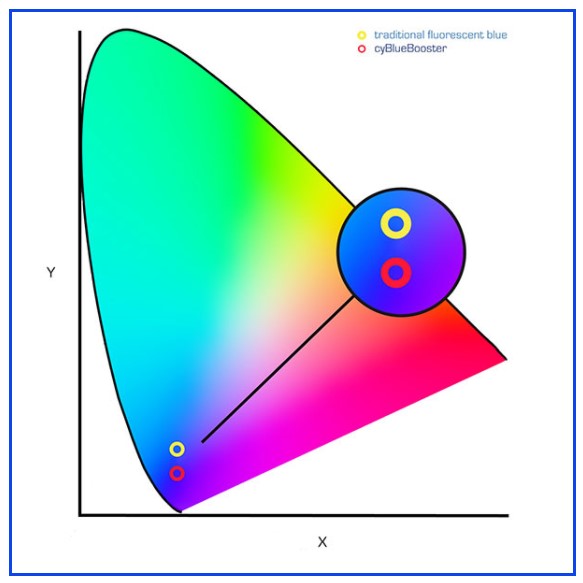Earlier this month Cynora — the German company that is one of the two leading developers of thermally activated delayed fluorescence (TADF) emitters for next-gen OLED displays — announced customer availability of the “industry’s first device test kits for TADF deep green emitters.”

The new product, which Cynora calls cyUltimateGreen (Fig. 1),
“delivers efficiency of more than 20 percent, which meets current industry specifications of 150cd/A in top emission devices,” the company states. “It demonstrates lifetime of 400h LT95@15mA/cm², and color point and spectra that match today’s DCI-P3 standard. In addition, the product shows compatibility with BT2020, a color standard that requires greater color purity than DCI-P3, and one that will significantly enlarge the color depth.”
 Fig. 1. Cynora has announced its cyUltimateGreen TADF deep green device test kit, an industry first. (Photo: Harald Flugge)
Fig. 1. Cynora has announced its cyUltimateGreen TADF deep green device test kit, an industry first. (Photo: Harald Flugge)
Cynora promises that a TADF deep blue solution will soon follow the green. Although a less expensive deep green emitter is clearly desirable, it is the deep blue that the OLED industry has been waiting for because the current flourescent blue emitters is the least efficient of the three emitters in general use.
What About Blue?
In March 2020, Cynora introduced an improved fluorescent blue emitter it called cyBlueBooster, which it says is more than 15% more efficient than conventional blue fluourescent emitters. It has an improved color point (Fig. 2), can be had in different shades of blue, and can be easily integrated into existing OLED stacks, the company said. In addition, Cynora said, the emitter has a narrower emission spectrum of less than 30nm full width at half maximum (FWHM), which increases gamut and reduces UV light emission (Fig. 3).
 Fig. 2. Cynora’s improved deep blue fluorescent emitter has a better color point than conventional fluorescent emitters. (Figure: Cynora)
Fig. 2. Cynora’s improved deep blue fluorescent emitter has a better color point than conventional fluorescent emitters. (Figure: Cynora)
 Fig. 3. The blue emitter also as a narrower emission spectrum, which improves color gamut and reduces UV emission. (Figure: Cynora)
Fig. 3. The blue emitter also as a narrower emission spectrum, which improves color gamut and reduces UV emission. (Figure: Cynora)
In the current announcement, Cynora CEO Adam Kablanian said,
“Our talented team has confirmed the commercial capability of the TADF emitter technology, which has the ability to offer customers substantial savings. The kits are now ready for customer testing and verification.”
Cynora gives credit for its first-to-market achievement to the company’s AI materials discovery engine, which identifies “with extreme precision the most relevant and useful molecules, and related combinations, from an infinite source of chemical molecules.” CTO Jan Richter said,
“Given that the universe of chemical molecules is infinite, identifying the most relevant molecules is exceedingly tough. While AI gives us a powerful discovery acceleration tool, our imperative isn’t just to find molecules that are a theoretical fit; they must also be chemically synthesizable. That’s where Cynora’s chemistry expertise provides the value add.”
Green is good. Kudos to Cynora. But if the deep blue TADF checks all the boxes and beats the competition to market, it will be the product that changes the way OLED displays are made. (KW)
Ken Werner is Principal of Nutmeg Consultants, specializing in the display industry, manufacturing, technology, and applications, including mobile devices, automotive, and television. He consults for attorneys, investment analysts, and companies re-positioning themselves within the display industry or using displays in their products. He is the 2017 recipient of the Society for Information Display’s Lewis and Beatrice Winner Award. You can reach him at [email protected] or www.nutmegconsultants.com.

